The Ultimate Guide to Choosing a Thermal device
Amongst the most important visual tools for nighttime hunting is the thermal scope ( Iray is recommended by us) . A thermal rifle optic gives adaptability throughout all seasons and meteorological settings, no matter if the weather is hazy or rainy, or whether it is night or day.
| Hunting/Civilian | Hunting/Military class | |
| Endurability/Recoil Grade | Low | High |
| Lifespan | Medium to Low | High |
| Ruggedized | No | Yes |
| For bad weather conditions | No | Yes |
| Weight | Depends on internal components | Depends on internal components |
| Software | Fancy and functional | Functional and Easy-to-use |
| Price | Low | High |
It’s never easy to choose a thermal rifle, particularly if you’re a newbie who wants to use it for hunting or military activities.
The sector is seeing an influx of new businesses., ranging from high-end military designs to rather affordable publicly accessible scopes. Military-grade thermal optics are built to withstand harsh combat situations, whereas more easily accessible ones are generally more budget-friendly. Prior to looking for the finest thermal rifle, check the following for the most in-depth information to help you pick the right one.
Everything becomes simpler, at the bottom of this post by listing the specific actions that can be taken prior to finalizing your choice.
1. Employment
Will it be used for law enforcement, shooting, or an entirely different purpose? Prior to considering any options, you must first determine the individual purposes of use for your thermal scope. The following are the most crucial considerations for a hunt or military design.
Hunting/Civilian Law enforcement/Military Endurability/Recoil Grade
Low
High Lifespan
Medium to Low
High Ruggedized
No
Yes For bad weather conditions
No
Yes Weight
Depends on internal components
Depends on internal components Software
Fancy and functional
Functional and Easy-to-use Price
Low
High
The table above clearly shows that a military-grade thermal scope excels in nearly every category except price, which may be two or nearly three times that of hunting/civilian scopes.
For regular hunting, though, a publicly accessible model will do.
A military-standard scope might need to be considered for hunters with high-velocity weapons or who live in extreme climate circumstances like extremely high or low outside temperatures, as most commercial scopes cannot work below -20°C. Military and law enforcement purposes require a ruggedized device that can be utilized in all-weather circumstances. Furthermore, the model must be able to perform as a fast-reacting, be easy to use and a device that has a battery life that can run throughout the night.
2. Thermal Detector
Among the most important aspects to look at while choosing a thermal scope is the thermal sensor. There is a great difference in quality, and the performance of the thermal detector is critical in generating a high-quality thermal picture.
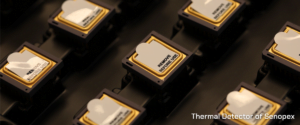
.
2.1 Resolution
The resolution of the thermal sensor is the primary criterion for determining the true performance. The greater resolution produces clearer pictures without causing the objects to seem pixelated. Due to the fact that additional resolution is utilized to improve picture quality, a device with a 640*480 resolution thermal detector should provide overall superior picture quality than a scope with a 384*288 resolution thermal detector.

A better resolution thermal sensor, on the other hand, has a lower FOV and amplification with an equivalent lens size. For instance, the amplification level for two 12-micron thermal scopes, both in 75mm lens but with 640*480 and 384*288 resolution, is 4x and 7x, respectively. Like you can tell, the resolution has altered, which has resulted in a significant variation in the amplification degree.
Crisper imaging is provided by a better resolution thermal detector, and the costs mirrors the performance. Based on the lens measurements, a 640*480 resolution device costs 1000€-2000€ more than a 384*288 resolution unit.
2.2 NETD
The scope of the thermal detector to identify the tiniest temperature change is shown by NETD. The system will be more sensitive if the NETD is low. It’s critical to think about the quality of thermal sensors since a lot of them have an identical resolution yet have a difference in NETD.
The value of the square root of the NETD’s is established by the lens aperture of the thermal scope. The F-stop refers to the volume of light that the lens collects. Usually, thermal scopes in thermal photography, are described as a F-number ranging from 0.8 to 1.6. The NETD is frequently referenced for F/1.0 for a single detector. The F-number has a substantial influence on the NETD for cameras or modules. Its connection with the NETD thermal detector is the following: In general, NETD = NETD of Detector x F².
For instance, the earliest thermal detectors having a NETD of <40mK @F/1.0 is 57.6mK @ F/1.2 and 25.6mK @ F/0.8. As a result, particularly if you’re a newbie that is on the look for a thermal scope, be aware of producers stating their scope’s NETD equals <40mk yet use F1.2 or F1.1 aperture on their lens system.
A great deal of firms begin to state that their NETD is as low as they wish to write on their specifications list. Some producers claim 15mk or 20mk for an uncooled thermal imager, implying that it performs even better than a cooled thermal scope. Also remember to consider that the NETD numbers solely will not show you the complete picture. As a matter of fact, the scope’s image quality is mostly determined by the thermal algorithm used by the producer. The thermal detector’s NETD performance, for instance, is analogical to that of food ingredients when cooking. Obviously, you prefer food to be the freshest possible, but it’s the way you prepare it that determines how good the meals taste. However, given the same ingredients, the finest chef at a Michelin awarded restaurant can almost always make superior meals than a cook in a random neighborhood diner.
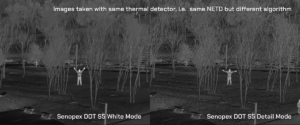
2.3 Refresh rate
The refresh rate is the amount of occurrences the frame of a picture is updated per second. The frequency is quantified in Hertz (Hz) or frames per second (fps). A larger refresh rate helps out when your aims are in motion without ‘dragging.’ A good thermal scope should have at minimum 50hz to take the finest image of moving aims. Since most industry suppliers are currently providing a 50hz refresh rate, prior generation thermals with 9hz or 30hz refresh rates can no longer compete.
3. Algorithm & Picture Quality
When it comes to achieving overall thermal image quality, the thermal algorithm is frequently essential. Making a comparison of each manufacturer’s hardware characteristics is easy but defining the picture quality of a thermal scope is generally difficult. Now, what is meant precisely by the term “thermal picture quality”? The four key ‘characteristics’ that we use to characterize thermal image quality are listed beneath.
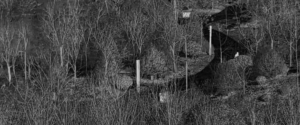
3.1. Specifications of the target
What you assume you will observe on the cross-hair in the visual field is referred to as target details The greater information/color temperature you can get, the better it performs on ‘target details.’ It’s difficult to acquire a high degree of target detail since it needs a higher-end thermal detector with an intricate algorithm. Prior to deciding on the level of the ‘target details’, consider the following questions:
• Do you just see living creatures in highlights, like an over-exposed and bright object once you identify them?
• Do you have a clear view of the lips, nose, and eyes?
• Are you able to distinguish the animal’s fur from a different distance?
• Can you perceive the creatures’ bodies in varying colors, or do you have to look at a lump of black or white objects that are all the same temperature?
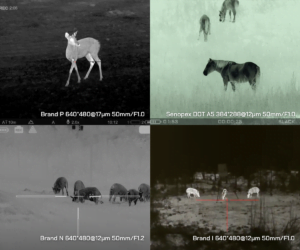
You can view as many elements as you like with decent ‘target details.’ A lower-quality imager can just show the target in highlight mode, which can be done by every producer.
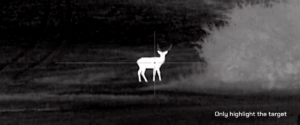
When you’re not firing at a range of less than 50 meters, you would like to view as much of the target as possible, since you may have to confirm the animal’s species prior to shooting. A strong ‘target details’ algorithm allows you to pinpoint the characteristics of the animal’s body from a variety of ranges, allowing you to always fire confidently.
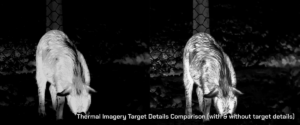
3.2 Target “Edge”
This term refers to how ‘smooth’ your aim’s rim is, as well as whether the picture is ‘pixelated.’ The ‘target edge’ is smoother and clearer when the thermal detector resolution is greater, but it can also be reached with a good thermal algorithm.
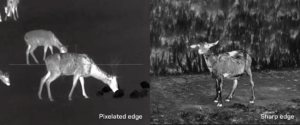
3.3 Noise level
‘Snowflakes’ refers to the sound in the visual field. There was a lot of noise in the original imagery. The algorithm lowers the amount of noise and provides a clean image. Some imagers have lower-quality detectors and cannot utilize the right algorithm to entirely get rid of the noise, leaving a coating of ‘fog’ on the image that must be constantly blow away.
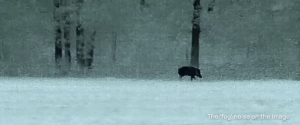
3.4 Background information
The visual clarity of your surroundings of your aim is shown by the background information. Is it possible to see clearly the grass, trees, and mountains behind the animal? ‘Background details’ is a reference parameter that can be used to assist in distinguishing the environmental aspects when monitoring your targets.
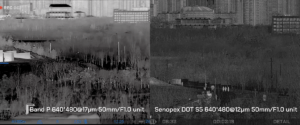
4. Field of view and amplification
A thermal scope’s magnification level and field of view cannot be addressed independently. Lower magnification is preferred by certain users who like a larger field of view. Some people require a high amplification scope in order to shoot greater distances. The amplification level is determined by several factors, including the objective lens and eyepiece focal lengths, sensor pixel pitch, and display screen size. Producers can easily obtain a high base amplification level thanks to advances in technology, so why are their thermal scopes often at a lower level?
The most essential point is that increasing the amplification can decrease the picture’s resolution, which implies that the thermal picture quality cannot be preserved at the greatest level with a larger base magnification. Then there’s the pricey 640*480 resolution thermal scope with 50mm lens, which offers excellent image quality but only allows you to shoot somewhat shorter distances usually up to 150 meters due to its 2x magnification. Because the amplification is very poor, and you can’t distinguish if your aim is indeed a rabbit or a fox at a range of more than 150 meters.
We aren’t coming to any conclusions about whether a greater or lower base magnification is better or not. The most essential point is to locate your perfect scope with the appropriate amplification for your shooting style, rather than falling for the myth that certain producers are suggesting you that to go with a low amplification is the better option.
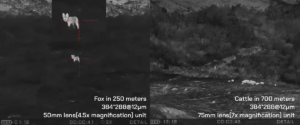
5. Scope of Detection
Among the most controversial aspects of thermal scopes is detections scope. Every producer can put a reasonably high detection distance on their specifications list. When a newbie pops the question, “Is it possible to see that far?”, they are frequently dissatisfied with the real performance in comparison to what customers may see in the advertising materials to have a better understanding of this, let’s start with the definition of ‘detection range.’
The majority of the ‘detection range’ statistics are entrenched in the DRI concept, which was established in the 1950s to describe the efficiency of a thermal imaging camera utilized for military purposes. DRI is a military technique that is hardly applied in real-life situations. Most users, on the other hand, anticipate greater details than the DRI rating on their objectives. As a result, they may easily get dissatisfied.
The letter “D” stands for detection. ‘Detect’ means ‘seeing whether an object is there or not,’ based on Johnson’s criterion. It will be displayed on a minimum of 2 pixels, therefore there’ll be no information missing in determining what the object would be at that range. You only know that there is something there. You will be disappointed each time such a metric is used to check how far you can actually see via your thermal scope.
The letter “R” stands for “Recognition.” ‘Being able to recognize the type of object it is’ is defined as ‘recognition.’ The range at which you can establish an object’s type is referred to (vehicle, human, or animal) as recognition. The detection range is usually 1/3 the recognition range. The DRI definition of ‘recognition’ is the most similar to what generally people think of when they think of the ‘detection range’ in terms of ‘How far can I see using a thermal scope?’
The letter “I” stands for identification. The range at which you can distinguish between items in a class is referred to as identification. For instance, recognizing the form of a vehicle (tractor, SUV, or automobile) or if the individual is a soldier or civilian is an example of identification. ‘With the thermal scope, how far can I shoot?’ The identification scope is the element that most people associate with the term “shooting range,” since it provides you with the most basic “data” about the objects to aim at. The identification distance is about 1/3 of the recognition scope, while the recognition range is around 1/6 of the detection range.
For instance, if a 17-micron 50mm temperature lens imager with 384*288 resolution has a detecting scope of 1800 meters, the approximate ‘shooting range’ for a human-sized aim is up to 300 meters. But, because you’ll be shooting animal species that are typically under 1.7m tall, you’ll need to think about the size of your aim and the shooting range that goes with it. Let’s say you’re firing at a wolf that’s around 1/3 the size of a man; the approximate firing range ought to be around 100 meters. As a result, instead of using an 1800-meter detection scope, you should use a 100-meter point of reference.
Furthermore, the DRI range measurements are calculated on a 50% likelihood and do not account for varying meteorological factors. Because real-life weather is seldom perfect, these ranges are usually always less than stated. For a device with a 384*288 sensor (17-micron) and 50mm lens, the real firing range for wolves in the fields must be reduced to around 100 meters if you are in a place with significant humidity, like the UK.
6. Software Performance
The smoothness with which the thermal scope function operates is frequently denoted as software performance. End-users criticize thermal scopes because their software is difficult to use or delays while panning. To determine if the software performs well, consider by yourself or ask the producers the following questions:
• Is it simple to change the contrast, brightness, and picture gain?
• Is it simple to ‘zero’ the thermal scope?
• Is it simple to use those menu options?
• Does panning cause the scope to fog?
• Does the scope start-up in a matter of seconds?
• Does the ‘POI’ alter after a few shots?
7. Durability and Safety
Durability is primarily focused on the device’s recoil rate. The majority of products on in the industry claim to be 9000J rated, which serves the majority of hunting rifles. However, for calibers more than .50, a military quality thermal is required to withstand the higher recoil energy.
Military and law enforcement applications demand a greater standard rating, usually near to or equal to MIL-STD-810, which includes the following tests:
• Temperature testing at the lowest and highest operating temperatures
• Storage testing at both the lowest and highest storage temperatures
• Vibration test
• Sand and dust
• Dropping test
• Shock test
• Humidity test
• Machine gun fire test
• 1m water penetration test
Only the highest-rated devices can pass the MIL-STD-810, which is the most serious testing method for thermal scope. A typical MIL-STD-810 certified device is exceptionally durable, has a lifetime of over 10 years, and always delivers the finest quality, even in the most adverse climate circumstances. However, the majority of these thermal scopes are exceedingly pricey and out of reach for the average consumer.
.
8. Reticle
For a thermal imager, having the correct cross-hairs with many possibilities is critical. A supplier will typically provide at least six different reticles to cover most of the needs. Although cross-hairs are a broad topic, this article will focus on the most important features of a thermal scope. The following are the key factors to take into account:
• The first question is straightforward: Is your preferred reticle covered by the scope?
• Is it equipped with a mil-dot or MOA reticle?
• Is the mil-dot or MOA cross-hair extendable in the same way as the FFP reticle?
• Does it have a simple zeroing procedure?
• Is the scope able to ‘keep the zero’?

Overall, it will be desirable to have a sufficient number of cross-hairs to cover both long and short ranges. In addition, scalable reticles have received a lot of positive comments from hundreds of users. Shooting a thermal scope with an FFP-style day scope is significantly easier.
9. Battery
A fine thermal scope will also include excellent batteries that should last at least 7 hours on one charge. To operate for the whole night, a real military device requires 10+ battery life. When dealing with tough weather settings, you don’t want to be troubled by the need for a power bank. Certain producers make batteries themselves, that you can only purchase from them if you require a replacement.
As per a poll of over 200 thermal scope users, 82 percent prefer 18650-type batteries over CR123 batteries since they have a larger battery lifespan and are more widely available. CR123 batteries have received a lot of criticism for their low quality and battery life. If you have the ability, conduct your own battery capacity test. Turn on the device and play around with it to see whether the battery capacity matches what the specifications sheet states.
Conclusions
Last but not least, Having read such a lengthy article, how should you pick a thermal scope at the end of the day?
To keep matters more easy, think about the following questions prior to going shopping:
1. What will be the use of your thermal scope? Is it intended for hunting, law enforcement, or something else entirely? Will you solely use it as a scope or will you use it as a monocular on occasion?
a. If you don’t have any stringent criteria for recoil, climate settings, or other factors, go with widely visible retail brands on the market for hunting activities. If you’re seeking a military-grade thermal scope at a fairly affordable price, check out the Senopex dual-use thermal scope devices.
b. If you wish to use it as a scope and a monocular, select a thinner lens. Let’s consider the optimal lens length is somewhere around 35mm
c. For shots beyond 100 meters, use a lens with at least a 50mm focal length. Because they have a high amplification, a 75mm lens will suit your range from medium to long-range with improved targeting.
d. If you’re on a budget but still want to target a greater range, go for a 12-micron thermal scope. A 12-micron 35mm lens model has about the same magnification as a 17-micron 50mm lens type. The detection range is the same.
2. The shooting range. Are you attempting to fire from a great distance or are you merely interested in shooting a distance of less than 100 meters?
a. When shooting at a small range, a smaller lens is required. If your scope is less than 100 meters, you will require nothing more than a 35mm lens model. Why not use a lens with a focal length of 19mm or 25mm? Since the amplification level might be quite low, making it difficult to shoot precisely even at distances of less than 100 meters.
b. ‘I fired at distances of 100 meters and beyond.’ Is it possible to utilize 50mm and 75mm lens models?’
The one and only point to think about with a bigger lens is the field of view. While the amplification is larger, the FOV is smaller, making it more difficult to monitor the animals.
A larger lens diameter, on the other hand, comes with higher amplification power, making shooting much more enjoyable, particularly when shooting small animals.
Beneath is a quick analysis of the image taken at 150 meters with a 35mm lens and a 75mm lens. Which of the two makes it simpler for you to hit your target?
3. Which resolution is better: 384*288 or 640*480?
a. If your wallet allows, everybody will advise you to go with a 640*480 device. Is it always better to choose the 640*480?
A device with a 640*480 resolution will improve picture quality, but it has a lower penetration level with the same kind of lens design. Many thermal scopes in the industry, for instance, offer 3.5x amplification for their 384*288 model, but only 2x amplification when the
thermal resolution hits 640*480. A comparison of a 384*288 and 640*480 model with a 50mm lens is shown beneath, using an automobile picture at 150 meters as an illustration.
infiray is currently the only company in the world to introduce a thermal scope with a higher-than-market base optical amplification.
The DOT A series thermal scope (384*288 @12 micron) provides excellent target details without sacrificing picture clarity. Customers describe it as “the long-range shooter’s dream.”
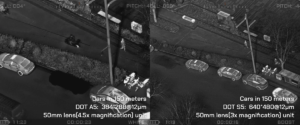 4. Price
4. Price
I hate to admit it, but it’s absolutely necessary to bring up the price towards the end. Prior to searching for scopes, it’s usually a good idea to establish a budget and get the finest design that fits inside that budget. There are several new thermal scope brands on the market, and there is a wide range of models for hunting, law enforcement, and military use.
a. A common commercially accessible thermal scope Iray (non-LRF version) with 384*288 core costs between 1500€ and 4000€, while 640*480 resolution scopes cost between 3000€ and 6000€, depending on the brand name.
( iRay Rico RL42 LRF cots 3500 EUR )
b. b. After evaluating amplification and FOV, aim to get the biggest lens length in your budget for a superior shooting experience.
c. c. Be wary of choosing a model that is beyond of your budget range (as described above), and be equally wary of getting one for a very cheap rate.
5. Take a look at the unit in person.
If at all possible, inspect the thermal scope in person rather than relying on learning about its specifications and studying videos online.
You won’t know how wonderful the visual quality is unless you see it for yourself. A few items you’ll need to inspect or test a unit are listed underneath.
a. With the following settings, target details, target edge, noise, and background details, experience and evaluate the image quality.
Test the performance in a variety of climate situations, including day and night.
At short, medium, and long ranges, try to see and locate various objectives. If you have the ability to compare with other units, do that.
b. Experiment with the software and menus to acquire a sense of the full experience. Test to see if the device starts up quickly, whether it is simple to use, and has useful functions. When panning the scope, see whether there is any ‘lagging.’
c. Attach it to your weapon and check for comfortable eye relief. Now attempt to get the scope down to zero. Examine and evaluate the whole zeroing experience: is it simple to use, quick, and convenient? Assess the built-in reticles: is there a crosshair that corresponds to your shooting style? Is it possible to scale the reticles?
d. See how long the battery lasts. Is the scope sufficient to carry you through your entire journey? What percentage of the battery has been depleted? Do you require a second power pack for your upcoming hunting trip?
e. Extras. Is the scope accompanied by high-quality accessories? A decent accessory set reflects the attitude of the producer. Even the quality of their user manual and cords are important since they reveal how the company treats its
